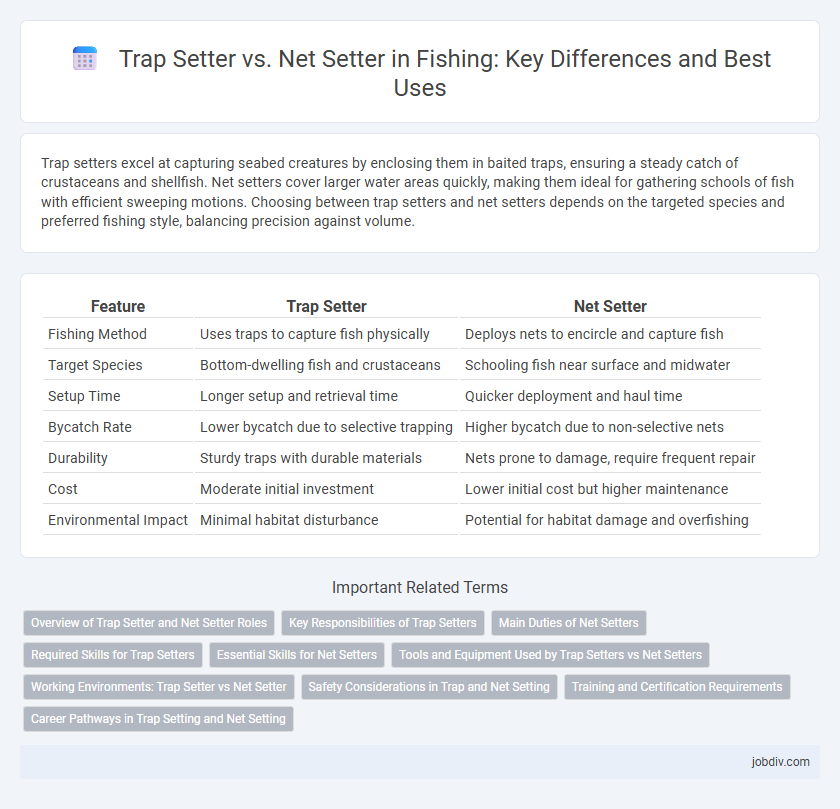Trap setters excel at capturing seabed creatures by enclosing them in baited traps, ensuring a steady catch of crustaceans and shellfish. Net setters cover larger water areas quickly, making them ideal for gathering schools of fish with efficient sweeping motions. Choosing between trap setters and net setters depends on the targeted species and preferred fishing style, balancing precision against volume.
Table of Comparison
| Feature | Trap Setter | Net Setter |
|---|---|---|
| Fishing Method | Uses traps to capture fish physically | Deploys nets to encircle and capture fish |
| Target Species | Bottom-dwelling fish and crustaceans | Schooling fish near surface and midwater |
| Setup Time | Longer setup and retrieval time | Quicker deployment and haul time |
| Bycatch Rate | Lower bycatch due to selective trapping | Higher bycatch due to non-selective nets |
| Durability | Sturdy traps with durable materials | Nets prone to damage, require frequent repair |
| Cost | Moderate initial investment | Lower initial cost but higher maintenance |
| Environmental Impact | Minimal habitat disturbance | Potential for habitat damage and overfishing |
Overview of Trap Setter and Net Setter Roles
Trap setters specialize in positioning baited or non-baited traps in strategic underwater locations to capture specific fish species, relying on knowledge of fish behavior and habitat. Net setters deploy various types of fishing nets, such as gillnets or seine nets, by casting or anchoring them to efficiently encircle and capture large quantities of fish. Both roles require precision in placement and timing, but trap setters focus on targeted catches while net setters optimize for volume.
Key Responsibilities of Trap Setters
Trap setters are responsible for strategically deploying traps to capture specific fish species, ensuring sustainable fishing practices by targeting appropriate habitats. They monitor trap locations regularly, check for catch status, and maintain equipment to prevent bycatch and environmental damage. Their role requires knowledge of fish behavior, tidal patterns, and trap techniques to maximize catch efficiency and comply with fishing regulations.
Main Duties of Net Setters
Net setters specialize in deploying and retrieving large fishing nets designed to capture schools of fish efficiently. Their main duties include setting the nets in strategic locations, monitoring the nets to prevent damage or loss, and ensuring timely retrieval to maximize catch and maintain fish quality. Precision and knowledge of fish behavior are essential for net setters to optimize their yield and contribute effectively to sustainable fishing practices.
Required Skills for Trap Setters
Trap setters require precise knowledge of fish behavior and habitat to strategically position traps for maximum catch efficiency. They must possess strong problem-solving skills to adapt trap placements based on environmental changes and water conditions. Expertise in maintaining and repairing traps ensures durability and functionality throughout the fishing season.
Essential Skills for Net Setters
Net setters must excel in precise net placement and quick deployment to maximize catch efficiency in various water conditions. Mastery in reading water currents and fish behavior enhances net positioning, reducing overlap and escape chances. Strong teamwork and communication skills are crucial for coordinating large-scale net operations and ensuring safety during deployments.
Tools and Equipment Used by Trap Setters vs Net Setters
Trap setters utilize specialized gear such as baited traps, hoop nets, and escape-proof cages designed to capture specific species with minimal habitat disruption. Net setters rely on various types of nets including gillnets, seine nets, and trawl nets, which are constructed from durable synthetic fibers and require boats or poles for deployment and retrieval. Both methods employ tools tailored to their capture techniques, with trap setters focusing on structurally rigid devices and net setters on flexible, expansive mesh materials.
Working Environments: Trap Setter vs Net Setter
Trap setters typically operate in shallow coastal waters or riverine environments where individual traps can be strategically placed near structures or habitats to capture target species. Net setters work predominantly in open waters, from estuaries to offshore locations, deploying large nets that require ample space and specific current conditions to maximize catch efficiency. Both roles demand a deep understanding of local ecosystems and environmental factors to optimize gear placement and ensure sustainable fishing practices.
Safety Considerations in Trap and Net Setting
Trap setters must prioritize secure placement to prevent accidental entanglement and injury, using clear markers and checking local regulations to avoid hazards to non-target species and humans. Net setters face risks from strong currents and large marine life, requiring proper training and safety gear such as gloves and flotation devices to minimize accidents. Both fishing methods benefit from routine equipment inspections and adherence to safety protocols to protect fishers and the marine environment.
Training and Certification Requirements
Trap setters and net setters require specialized training focused on gear handling techniques to maximize catch efficiency and minimize environmental impact. Certification programs typically cover safety protocols, species identification, and sustainable fishing practices, ensuring compliance with regulatory standards. Employers often mandate completion of recognized training courses to demonstrate proficiency and promote responsible fishing operations.
Career Pathways in Trap Setting and Net Setting
Career pathways in trap setting often involve specialized training in handling and deploying various types of traps for species such as crab, lobster, or fish, with a focus on sustainable and efficient catch methods. Net setting careers emphasize expertise in using gill nets, seine nets, or trawl nets, requiring knowledge of marine environments, species behavior, and net maintenance to maximize yield. Both career paths demand strong physical endurance, safety awareness, and adherence to regulatory practices to support long-term fisheries management.
Trap Setter vs Net Setter Infographic

 jobdiv.com
jobdiv.com